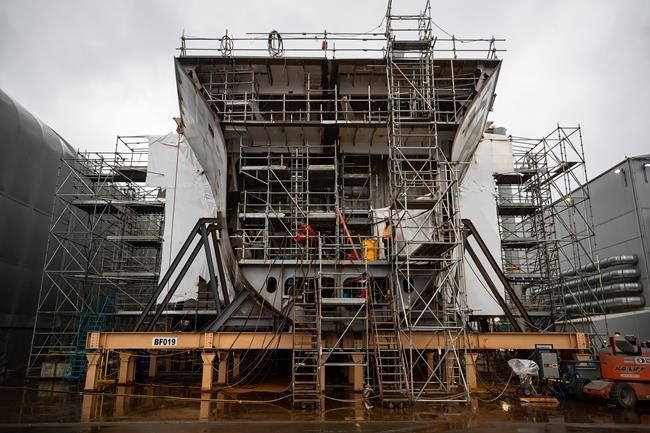OTTAWA — The Defence Department's top procurement official is warning of fresh delays in the delivery of already overdue warships and other new equipment to the Canadian Armed Forces because of COVID-19.
Assistant deputy minister of materiel Troy Crosby says the Halifax and Vancouver shipyards building new fleets for Canada's navy and coast guard have been hit particularly hard by lockdowns and supply chain disruptions.
And while the government is working with the shipyards to determine the full extent of the problem, Crosby tells The Canadian Press in an exclusive interview that their already revised delivery schedules will slip yet again.
“The shipbuilding projects ... are the ones where we probably are going to see cumulatively the largest impacts,” he said, adding: “There's going to have to be a schedule adjustment.”
Any schedule slippage will delay delivery of much-needed new ships for the navy's aging fleet, which has seen two support ships and three destroyers retired over the past decade, vessels that still haven't been replaced.
It will also mean even higher costs for the more than 20 navy and coast guard ships currently being built or which have yet to begin, all of which have seen their budgets increase as a result of past delays.
Parliamentary budget officer Yves Giroux laid out the potential cost increases for just one project in a report last week in which he pegged the price tag of the government’s plan to build two polar icebreakers for the coast guard at $7.25 billion.
The budget watchdog’s report estimated a one-year delay would add $235 million to the overall cost, while a two-year delay would result in a $472-million increase. Ottawa initially budgeted $700 million in 2008 to build one icebreaker.
Giroux has also predicted a one-year delay in delivery of 15 new warships for the navy would add $2.3 billion to his current estimated cost of $77 billion, while a two-year delay would result in the fleet costing $4.8 billion more.
Government officials have previously dismissed Giroux’s figure of $77 billion, insisting the warships’ $60-billion budget remains sufficient thanks to built-in contingencies and what they say are errors in his calculations.
But each significant budget overrun sets up a potential debate within government around whether to throw more money into the project or cut back on the number or quality of ships that it plans to buy.
Crosby acknowledged without providing details that cost increases are likely, noting recent stresses on supply chains alone have made it more expensive to buy and transport materials to the shipyards for those vessels currently under construction.
Various lockdowns and other public health measures have also resulted in lost productivity, Crosby said, with the shipyards having to close at different times and implement physical distancing and other measures to prevent the spread of COVID-19.
“More recently, so in the last few months, the shipyards have been reporting that they’re seeing quite a bit of churn, quite a bit of turnover, in their workforce,” he said, adding the problem has been exacerbated by a shortage of qualified college graduates.
Representations for Irving and Seaspan did not immediately respond to requests for comment on Tuesday.
Crosby says other military procurement projects are being affected by the pandemic as well, including the expected delivery of new search-and-rescue aircraft to replace the Royal Canadian Air Force’s ancient fleet of Buffaloes and older-model Hercules.
The new Kingfishers are being built in Spain, and travel restrictions have delayed delivery of several of the aircraft, though the air force says it is pressing ahead with plans to finally retire the 50-year-old Buffalo fleet next month.
Other projects such as the move to buy new fighter jets are moving ahead despite the pandemic, Crosby said, adding the government is still hoping to get the first replacement for Canada’s CF-18s in 2025.
Yet the shipbuilding projects are his top concern, and while the government is working with the shipyards to ease the effects of COVID-19, “whether it’s significant or not is going to depend on whether or not it’s long-term,” he said.
“We’re all waiting to see exactly what the longer-term implications are.”
This report by The Canadian Press was first published Dec. 21, 2021.
The Canadian Press



